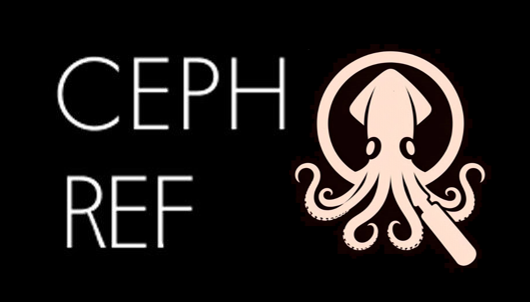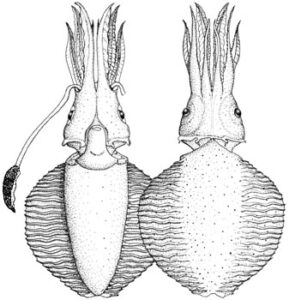Chtenopteryx canariensis
This species differs from all other members of the genus in the lack of photophores on both the eyes and viscera. It is known from four squid taken from the eastern tropical Atlantic Ocean.
A Ctenopteryx ...
- without photophores.
- with club suckers in 16-20 series.
- with arm suckers in 8-14 series.
The type locality is 26°20'N, 19°21'W, Eastern Atlantic just south of the Canary Islands. Other localities: 12°16'N, 23°05'W, 0°20'N, 25°20'W. All specimens were caught in nets that fished to 1000 m.
- Dark combfin squid
- Tentacles
- Club with six suckers in transverse row at proximal end, 16-20 suckers at mid-club, then decreasing number of suckers toward tip.

Figure. Oral view of the tentacular club of Chtenopteryx canariensis, holotype. Drawing from Salcedo-Vargas and Guerrero-Kommritz, 2000. Scale bar is 10 mm.
- Club with six suckers in transverse row at proximal end, 16-20 suckers at mid-club, then decreasing number of suckers toward tip.
- Photophores
- Photophore absent from viscera.
- Photophores absent from eyes.

Figure. Ventral view of the mantle cavity of C. canarensis holotype. Note the absence of a visceral photophore. A - Funnel locking apparatus. B - Ink sac. C - Nephridiopore. D - Spermatophore sac (= Needham's sac). E - Gill. Drawing from Salcedo-Vargas and Guerrero-Kommritz (2000).
- Arms
- Arm formula: IV=II>I=III.
- Arm IV 50% of ML.
- Suckers of arms I-III in 2 series proximally and up to 8-10 series in mid-arm portion (photograph on right).
- Arms II suckers in up to 12-14 series in distally portion.
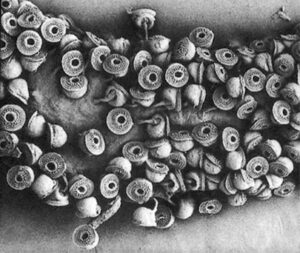
Figure. Scanning electron micrograph (SEM) of the mid-region of arm I, paratype, immature female, 55 mm ML. - Inner sucker rings with 5-6 blunt, rounded teeth (photograph below, left).
- Outer sucker rings with 3 concentric rings of polygonal plates surrounded by a ring of smaller and more narrow plates (photographs below).

Figure. SEM of arm sucker, paratype, immature female, 55 mm ML. 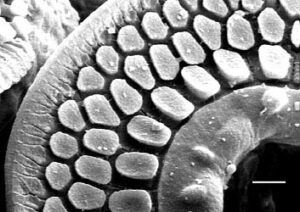
Figure. Same sucker, higher magnification. Bar = 10 microns.
- Tentacular club
- Club with six sucker in transverse row at proximal end, 16-20 suckers at mid-club, then decreasing number of suckers toward tip.
- Club length 30% of ML.
- Club slightly expanded.
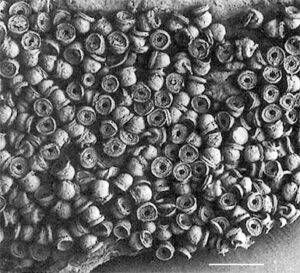
Figure. Oral view of middle region of club, SEM, 55 mm ML. Bar = 300 microns. - Inner sucker ring with about 9 blunt, rounded teeth.
- Outer ring with two concentric rings composed of elongate polygonal plates.
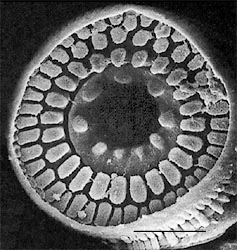
Figure. Oral view of club sucker, 55 mm ML; bar = 30 microns. 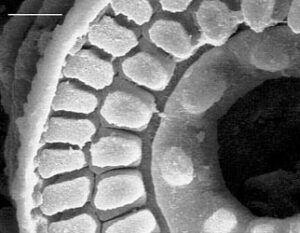
Figure. Same club sucker, enlarged; bar = 10 microns.
- Buccal crown
- 16-18 suckers, in 2-3 series, on each buccal support.
- Mantle
- Width 43% of ML.
- Occipital region
- Occipital crest prominent.
- 3 occipital folds present.
- Olfactory organ at base of Occipital fold I.
- Fins
- Fin length about 97% of lateral ML at 12 mm ML and 99% at larger sizes.
- Width across fins and mantle about 95% of ML.
- Length of longest fin ribs: 31-40% of ML.
- Each fin with 28 muscular ribs.
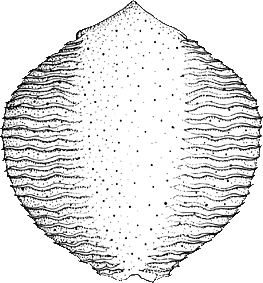
Figure. Dorsal view of fins and mantle, holotype.
- Gladius
- Free rhachis 44% of ML.
- Gladius with broad conus.

Figure. Ventral view of gladius of holotype. Scale bar is 10 mm.
- Spermatophore
- Drawing is a spermatophore of the holotype and an enlargement of the ejaculatory apparatus.

Measurements
Squid | ZMH 2778 | ZMH 2780a | ZMH 2779 | ZMH 2780b |
Sex | Imm. M. | Imm. M. | Imm. F. | Juvnile |
ML, mm | 65 | 63 | 55 | 12 |
MW, %ML | 43.8 | 31.7 | 43.6 | 58.3 |
Fin L, %Lat. ML | 97.6 | 95 | 96.8 | 97.9 |
Fin W, %ML | 107.6 | - | 109 | 250 |
Arm I, %ML | 47.6 | 44.4 | 52.7 | 45.8 |
Arm II, %ML | 36.9 | 47.6 | 60.9 | 58.3 |
Arm III, %ML | 47.6 | 49.2 | 47.2 | 50 |
Arm IV, %ML | 36.9 | 44.6 | 58.1 | 56 |
Club L, %ML | 30 | - | 32 | 29 |
Fin Rib L, %ML | 38 | - | 40 | 31 |
Gladius W, %ML | 18.5 | 18.1 | - | - |
Table of measurements modified from Salcedo-Vargas and Guerrero- Kommritz, 2000.
Most illustrations are from Salcedo-Vargas and Guerrero-Kommritz, 2000. The photographs showing portions of the arm and club suckers are slightly different from photographs seen in the type description. Photographs were taken by M. A. Salcedo-Vargas.
Salcedo-Vargas, M. A. and J. Guerrero-Kommritz. 2000. Three new cephalopods from the Atlantic Ocean. Mitt. Hamb. Zool. Mus. Inst., 97: 31-44.
